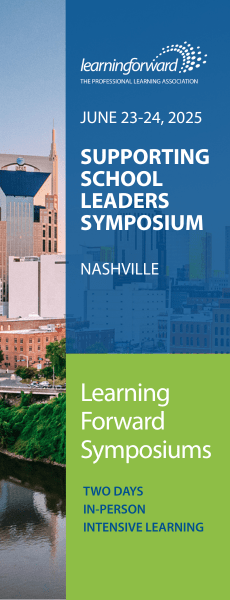Winning Strategy:
Set benchmarks of early success to build momentum for the long term.
By Jody Spiro
Establishing and meeting benchmarks of success early in the change process demonstrates to everyone that achieving the change goals is feasible and will result in benefits for those involved. The Early Win Wonder Tool can help leadership teams develop these “early wins” and decide which to choose.
Record, Replay, Reflect:
Videotaped lessons accelerate learning for teachers and coaches.
By Jim Knight, Barbara A. Bradley, Michael Hock, Thomas M. Skrtic, David Knight, Irma Brasseur-Hock, Jean Clark, Marilyn Ruggles, and Carol Hatton
Researchers at the University of Kansas conducted a three-year study to analyze what happens when coaches and teachers watch themselves on video. The results show why the video camera is an essential tool to provide an accurate, objective view of professional practice and to propel educators into improving their practice.
Connect the Dots:
A dedicated system for learning links teacher teams to student outcomes.
By Bradley A. Ermeling
Researchers find that a stable, protected setting where educators can focus on improving practice is key to building coherence and sustaining professional learning in a school or district. Their study, conducted over two decades, shows that schools with nonnegotiable times and places for learning as well as ongoing support demonstrated significant gains in student achievement in some of the most challenged districts.
Coaching Protocol Gives Rural District a Common Language for Learning.
By Marjorie C. Ringler and Debra O’Neal
In a yearlong series of workshops, the authors focused on coaching as a vehicle to improve academic language proficiency in a rural North Carolina district using the Sheltered Instruction Observation Protocol, a research-based model for integrating language and content in the classroom. Through the three phases of the protocol, teachers learned to lead and learning shifted from teacher-centered to student-centered.
Problem Solved:
Middle school math instruction gets a boost from a flexible model for learning.
By Jennifer Jacobs, Karen Koellner, and Joanie Funderburk
When a Colorado district introduced a new initiative called the problem-solving cycle to improve middle school math instruction, schools were initially reluctant. But as word of the program’s adaptability spread, so did participation. By the third year, all of the district’s middle schools elected to take part. Positive feedback coupled with ongoing district support ensures the program’s sustainability.
Deep Learning Takes Root:
A commitment to improve math instruction results in a multilayered learning community.
By Mary Ann Jacobs
When teachers at a small elementary school in New Jersey learned that just 2.5% of students were performing at grade level in math, they developed a three-level program of community learning that would enable students to succeed. After two years, test results showed that students were learning more, in more ways, more of the time — and so were the teachers.
A United Commitment to Change:
Districts and unions collaborate to implement school improvement plans.
By Ellen Holmes and Staci Maiers
To achieve successful school reform, a school improvement plan must engage the people closest to it, and the best way to reach and engage those people is through the associations that represent them at local, state, and national levels. In Indiana and Washington, school leaders worked with teachers associations to transform schools using funding from the federal School Improvement Grant program.
Feature
Strategies Click into Place:
Online resources translate research to practice.
By Yael Kidron
Doing What Works is a website dedicated to helping educators implement effective educational practices by providing an array of online, research-based resources for school improvement. The website, organized around a three-step cycle of learning, seeing, and doing, includes expert interviews, school-site videos, and tools and templates to implement practices.
Columns
Cultural Proficiency:
Cultural proficiency means having the courage to act despite risks.
By Patricia L. Guerra and Sarah W. Nelson
Cultural proficiency exists when educators are willing to take risks in support of equity, diversity, and justice. Outcomes in two districts illustrate the difference.
Collaborative Culture:
A willingness to speak the truth serves as a call to action and an important first step.
By Susan Scott
Being “nice” stood in the way of progress for one elementary school leadership team. A few core strategies cleared the path for honest and constructive conversations based on trust.
From the Director:
Implementation keeps great ideas going — and growing.
By Stephanie Hirsh
Implementation is essential to linking professional learning to changed practices and transformed results.
Learning Forward is the only professional association devoted exclusively to those who work in educator professional development. We help our members plan, implement, and measure high-quality professional learning so they can achieve success with their systems, schools, and students.
Recent Issues
BUILDING BRIDGES
December 2024
Students benefit when educators bridge the continuum of professional...
CURRICULUM-BASED PROFESSIONAL LEARNING
October 2024
High-quality curriculum requires skilled educators to put it into...
LEARNING TO PIVOT
August 2024
Sometimes new information and situations call for major change. This issue...
GLOBAL PERSPECTIVES
June 2024
What does professional learning look like around the world? This issue...










